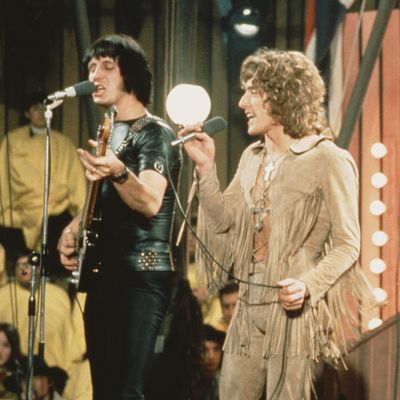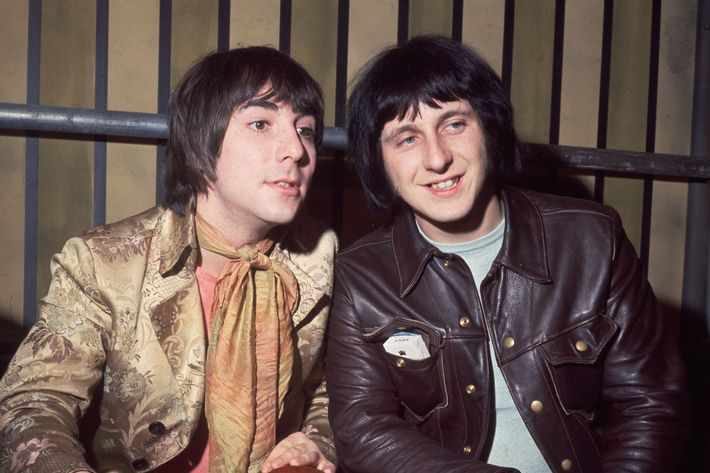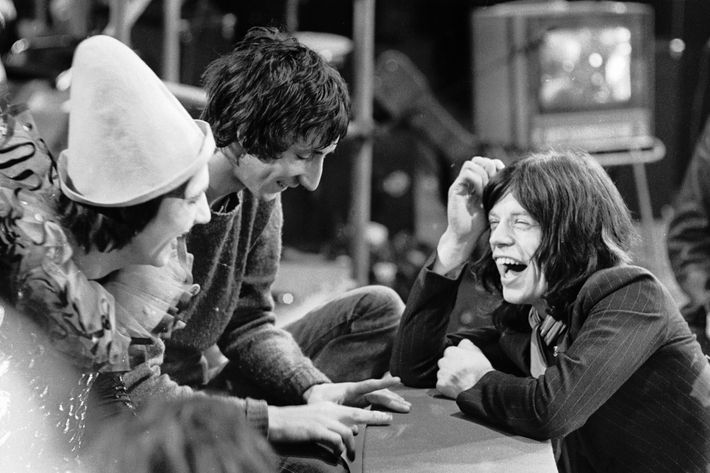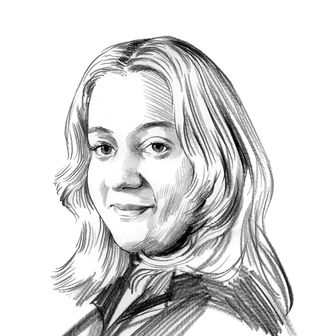
The gossipy spiral of the Who’s press tour for their new album, WHO, likely prevented you from checking out something truly magical transpiring on the band’s YouTube page: Over the past few weeks, a bunch of beautifully restored videos have been uploaded from their glory years, ranging from a “You Better You Bet” promo in 1981 to the sublime The Kids Are Alright sessions in 1978. The pièce de résistance of these uploads, though, transports us back to December 1968. The Who performed their mini rock opera, “A Quick One (While He’s Away),” as part of The Rolling Stones Rock and Roll Circus concert film, which in itself is the stuff of rock folklore that could warrant an oral history or ten. (And it has.)
For the uninitiated, Rock and Roll Circus was organized by the Stones as a means of (1) trying a different type of press for their new album at the time, Beggars Banquet, and (2) because who the hell wouldn’t want to spend a day dabbling in music and drugs with the Who, John Lennon, Eric Clapton, and other legends? While wearing snazzy ringleader hats? Without spoiling the performance too much, Roger Daltrey, Pete Townshend, Keith Moon, and John Entwistle delivered a textbook definition of “rock” that night, which becomes even more iconic when you remember that the special wasn’t released until 1996 — which may or may not have been because Mick Jagger was jealous that he was outperformed at his own gig. But more on that later.
(It should be noted, though, that this “A Quick One” performance was cleared for use in 1978’s The Kids Are Alright as a stand-alone vignette, but the quality was subpar. You could barely see Entwistle’s spiky shirt sleeves!)
Vulture gave the venerable director of Rock and Roll Circus, Michael Lindsay-Hogg, a (not quick) call to learn more about what it was like to be in the room where it happened more than 50 years ago. He took some time out of fine-tuning his art show in Paris to discuss his favorite behind-the-scenes memories, his best shots, and the power of Townshend’s blue eyes.
Your relationship with the Rolling Stones ran deep prior to this special. But what was your association with the Who like?
I had worked with them since 1965. I used to direct a live rock-and-roll television show called Ready Steady Go!, and they were on it a lot. That show really broke the Who in a way. The producer at the time was a great admirer of the Who, and made sure to book them for the show a lot. I also directed the videos for “My Generation,” “Substitute,” and “Anyway, Anyhow, Anywhere.” It wasn’t like I was listening to the Who; I was actually working with them. But the relationship with them goes deeper.
I attended Oxford for a year and I met Kit Lambert, who would go on to be the Who’s manager. We weren’t exactly friends at school, but we noticed each other. When I was taking over Ready Steady Go!, I heard a voice in an adjacent office and it was Kit. He and Chris Stamp [the Who’s other manager] were talking about what would later be the first song they performed on the show. So my relationship with them was really through their managers at first, who I grew to love very much. The Who was its own person. They were constantly fighting. I love Pete and still do; we email each other fairly often. I would later share an apartment with Kit and my girlfriend in London, and Pete would come over a lot.
What would you two talk about?
Let’s just say I knew pretty early on what an important songwriter Pete was. It seemed to be the Beatles wrote about love, the Rolling Stones wrote about sex, and Pete wrote about society. He was brilliant and witty and he still is. He’s very major.
What circumstances led to the creation of Rock and Roll Circus? I’d love to know how a Mick Jagger brainstorm session works.
It was my idea. The Beatles had done Magical Mystery Tour by this time, and the Rolling Stones and the Who were always neck and neck with them in terms of creativity. The Stones really wanted to do their own show. In the summer of 1968 I did the band’s first video for “Jumpin’ Jack Flash,” and a couple of months after Mick Jagger called me and said, “We want to do a TV special. I’m not sure what I want, but know I want you to direct it.” If Mick says he wants you to do something, you say yes. So I’m sitting in their office having been charged with coming up with an idea a few days later, and I was doodling on a pad trying to conceptualize something. I started to draw circles, circles, circles. A flash of inspiration came to me so I called Mick up immediately and I said, “I have seven words, The Rolling Stones Rock and Roll Circus.” He loved it.
How did you corral the Who to participate?
We thought of who we wanted, “we” at that point being the Rolling Stones and myself. All of the acts came out of a little address book in the back of [Jagger’s] pocket. The first call went to Pete Townshend and right away he said yes. The first band that everybody wanted was the Who, and they were the first band that said yes.
Did Mick specifically want them to play “A Quick One”? Or was that a Who decision?
The latter. The band chose it specifically and were really excited to perform it live. Nobody challenged them, Why not do this one instead? The musical decisions were always Pete, Roger, Keith, and John. They chose it and the rest is history.
What do you remember in the hours leading up to their performance?
Something annoying was that the cameras kept breaking down because they were new models, so every 20 or 25 minutes an engineer would have to come out and do some work. We had long delays in the afternoon because of this. To pass some time I remember going backstage into a dressing-room area and looking through a door, and together in a room were Pete Townshend, Mick Jagger, Keith Richards, and Eric Clapton hanging out and playing their guitars with Keith Moon playing with spoons on the table. I remember thinking this was a perfect image for the best of rock and roll. Of course they were rivals, but they staggered their releases so they weren’t in direct competition with each other. They wanted to be the best and were all competition. But they were great friends. Rock and Roll Circus couldn’t have been put together if everyone wasn’t part of a mutual-admiration society. If I had a Polaroid camera, that’s an image I would’ve taken and saved.

How was the Who interacting with each other before the cameras started rolling? Did they seem nervous?
They’d been touring quite recently before the show, so they were hot and in a groove at that point. They knew what they were doing. The call for everybody to show up was noon, as we figured that was the earliest anybody would get there. Unusually, everyone turned up on time. The Who, Eric Clapton, John Lennon, Yoko Ono, everyone. They all respected each other and each others’ time. But the Who in particular seemed relaxed and excited to be there. There’s a great photo of Keith and Pete sitting in the bleachers and Mick is next to them, and they’re all having a nice laugh. I bet Keith said something funny.
The Who wanted to do really well. The stakes were high. Their blood was up like an athlete. They were in a room with the greatest of greats. That didn’t make them nervous, but excited and ready to get onstage. As far as I remember, they got onstage about 4 p.m., so they weren’t tired. We did one rehearsal for the sake of the cameras and to give them a warm-up. They knew when it was over that they really rocked and rolled. They were very aware of what they had just done, which was an extraordinary performance. And not to sound immodest, but if anyone was going to shoot them well, it was going to be me.

Speaking from a director’s perspective, how did the song having six distinct movements influence how you shot all the action?
The action going on was definitely affected by the song’s movements. When it’s at the most hectic point, when Keith is playing and has water and sweat all on top of his drum kit and is going half-insane with drumming pleasure with bits of water shooting up, it’s perfect for the camera. I was more aware of how they were going to perform each bit. What it was going to be, I almost didn’t care because I knew in their hands the movements of the song would be wonderful. I was looking for the physical moments — when John would come in with his lyrics, when Roger would swing the microphones, things like that. I wanted to keep everything very intimate. If you look closely, the band is standing on a very small stage, which is similar to when they were starting out in little clubs. Same with the Stones later that night, too.
Is there a defining shot for you? I can’t get enough of Pete’s windmilling.
I love it when Keith throws the drum over his head and back into the wings. That’s the announcement of Fasten your seat belts, this is going to go off. Of course I love Pete’s windmilling, too. I’ve been a Pete superfan for 50 years. But I love at the very end when he says, “You’re all forgiven,” with his beautiful blue eyes and his sly smile. Everybody in the audience knew something sensational had just occurred in those seven minutes.
The folklore that evidently emerged was that Mick was jealous of the Who outperforming the Stones — so he wanted to ensure the footage was buried. Is there much truth to that?
It wasn’t so much that Mick thought the Who was better. It was that the Rolling Stones weren’t as good as they usually were. It was partly because Brian Jones wasn’t well. He couldn’t really contribute at all on the guitar, except for a few chords. They also didn’t go onstage until about 2 a.m. They’d been hanging around all day, which took its toll a little bit. They were tired and maybe drugged out. There was an idea that we were going to come back the next day to reshoot the Stones, but it was too expensive to keep the studio for another day. But ultimately Mick understood they weren’t as hot as they could’ve been and acknowledged the Who was quite good.
Since you and Pete have remained friendly with each other, has he ever brought up this performance through the years?
No. Everybody had kind of moved on after that day, including Pete, as weird as that may sound. The Who was on their way to building an enormous career, and that’s what they were focused on. I like to think he’s looked back on it privately.
This interview has been edited and condensed.


